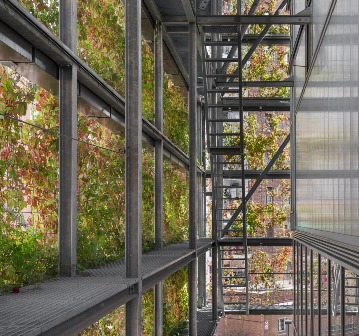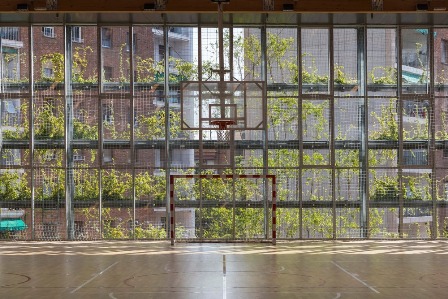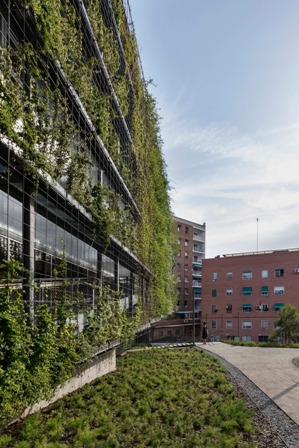Turó de la Peira’s Sports Center and layout of the interior urban block
Barcelona, Spain
Anna Noguera, Javier Fernandez
Urban regeneration with a green infrastructure
In 2014 the Barcelona City Council held an architectural competition for the landscape planning of an interior urban block and a sports facility consisting of an indoor heated swimming pool and a sports court.
The winning proposal was valued for its landscape integration of a singular greened building in an interior urban block and its commitment to sustainability and respect for the environment as per information available from v2com.
Preexisting Conditions, a Harsh and Desolate Urban Environment
Turó de la Peira Quarter is characterized by the abundance of low-cost social housing from the ’60s and a high density of buildings. A district with a lack of green areas and a shortage of public facilities.

The urban environment before the intervention was an unstructured space consisting of a sum of residual spaces. A space occupied by a sports court tucked between neighbouring buildings, a pool of obsolete facilities. An urban landscape of hard pavement, concrete walls and total absence of vegetation.
Urban Regeneration with a Green Infrastructure
The concentration of the two facilities in a single building allowed to free space to create a new garden.
A space of permeable surfaces, where the unleveled slopes are bridged with green slopes. A place of social relationship, a preamble to the new facility. A garden that provides quality of life and serves as a support of biodiversity.

Volumetric Integration, the Building is One Further Element of the Garden
The new facility is composed of the overlap of two large spaces; a Heated swimming pool on the ground floor and sports court on the upper floor.
The building is placed half-buried, adapting to the topography and bridging the difference in level between the two streets. The facade to Sant Isle Street has an urban character, with a corner porch that extends the sidewalk and invites us to enter.
The building minimizes its impact on the garden with a green gallery that surrounds it. The volume is one more element of the garden, not mimicking but dialoguing with it.
Naturalize Interior Spaces
The proposal places special emphasis on the perceptions that the space transmits to the user. The natural lighting, the vegetation and the use of wood provide a warm atmosphere, away from the coldness of other similar facilities.
Energy Efficiency and Self-Sufficiency
Passive Architecture
The design of the building has been carried out with passive architecture criteria. The compact and embedded volume in the ground minimizes the façade surface avoiding thermal losses.
The climatic conditioning and ventilation of the court take place exclusively with natural systems. 24 skylights and lateral windows monitored by sensors, ensure proper cross-ventilation and lighting.
The thermal insulation of the whole enclosure has been selectively treated according to solar orientation.
Use of High-Efficiency Systems:
The building has an aerothermal system that allows the recovery of heat for the production of hot water.
Renewable Energy Production:
The photovoltaic panels occupy the entire roof deck and generate 95.534 kWh per year.

Construction Systems and Materials Sustainability:
100% Prefabricated Laminated Wood Structure
The excellent characteristics of the wood concerning its lifecycle were one of the reasons for choosing the prefabricated system in laminated wood. It was also assessed its good mechanical performance, its adequacy to the environment of the pool, its lightness and consequent savings in the foundations and its short construction time (8 weeks).
Green Facade:
A green gallery surrounds the building protecting it from the sun and creating a bioclimatic space. The plantation system is hydroponic, chosen for its lightness, the durability of the substrate, the capacity of water retention and ease of installation.
From the court, the entire green facade is perceived through the curtain wall, enjoying its flowering changes according to the time of the year.
Water Recycling:
A large tank located in the basement collects the water from the roof for recycling and use for the entire irrigation of the green facade through a hydroponic system.
In the garden’s site development, draining strips at the bottom of the slopes collect rainwater to return it to the water table.
About:
Arquitectura Anna Noguera studio was founded in 1992, has a wide experience, and is recognized for the awards received and the dissemination of its works. The study work is characterized by the careful look at the context and landscape, the return to the traditional materials and techniques from a contemporary vision and the sustainability and technological innovation understood as intrinsic parts of the project.


